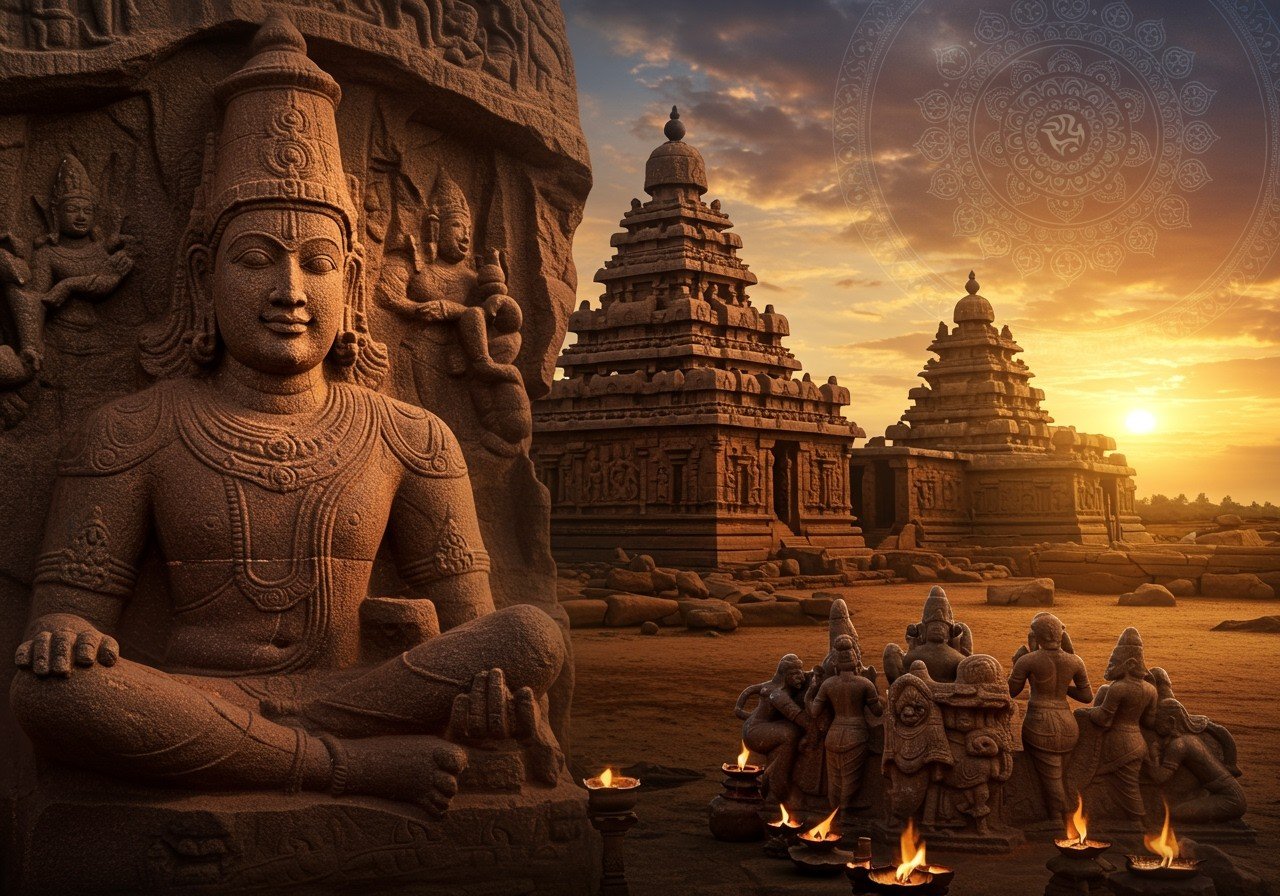
The Pallava dynasty, prominent in South India from the early 7th to late 9th centuries, left an indelible mark on art, religion, and administration. This article explores their significant contributions, focusing on their architectural marvels, religious practices, and administrative structure.
Pallava Art and Architecture: Pioneers of Dravidian Style
The Pallavas were pioneers of Dravidian architecture, transitioning from brick and timber to stone temples. Their intricate carvings and monolithic structures are evident in the rock-cut temples of Mahabalipuram, a UNESCO World Heritage Site. The Shore Temple, built during Narasimhavarman II’s reign (around the 8th century), stands as a testament to their architectural brilliance. The Varaha Cave Temple, with its detailed bas-reliefs, depicts scenes from Hindu mythology, showcasing the artistic skills of Pallava sculptors.
The Kailasanatha Temple in Kanchipuram, constructed by Rajasimha (around the 7th-8th century), is among the earliest structural temples, featuring elaborate carvings and inscriptions. The Pallavas’ influence extended beyond their kingdom, inspiring architectural styles in Southeast Asia, particularly in Cambodia and Indonesia.
Looking for exquisite statues and idols for your home temple? Explore our collection of divine figures at Poojn.in. We offer a wide variety of deities, crafted with intricate detail and reverence.
Religious Contributions: Patronage and Devotion
The Pallavas were instrumental in the spread of Hinduism and patrons of Shaivism, evident in the numerous Shiva temples they built. They also supported Vaishnavism, constructing temples like the Vaikuntha Perumal Temple at Kanchipuram. The dynasty played a key role in the Bhakti movement, emphasizing personal devotion, which influenced Tamil literature.
The Pallavas facilitated the construction of cave temples, serving as centers for religious and educational activities. Their patronage extended to Jainism and Buddhism, promoting religious tolerance. Kings often identified with deities, incorporating divine symbols in inscriptions, reflecting their devotion and legitimizing their rule.
Enhance your spiritual practices with authentic puja items from Poojn.in. We offer a wide range of high-quality products for all your worship needs.
Administrative Innovations: A Foundation for Future Kingdoms
The Pallavas established a well-organized administrative system that influenced later South Indian kingdoms. The kingdom was divided into provinces called ‘Mandalam,’ governed by provincial governors. They introduced the ‘Ur’ and ‘Nadu’ system, local units facilitating efficient governance.
The Pallavas maintained a strong military, focusing on cavalry and naval forces. Land revenue was the primary income source, and they implemented systematic land surveys. They supported trade, establishing relations with Southeast Asia. The Pallavas promoted education, with temples serving as learning centers. Their inscriptions, in Tamil and Sanskrit, provide insights into their practices, social structure, and achievements.
FAQs on Pallava Dynasty’s Cultural Contributions
What distinguished Pallava art and architecture? Rock-cut temples, intricate carvings, and structural temples were key features. Mahabalipuram’s Shore Temple and the rock-cut temples exemplify their style.
Which deity did the Pallavas primarily worship? While they also honored other deities, the Pallavas primarily worshipped Lord Shiva, as evidenced by numerous dedicated temples.
What was the Pallava Dynasty’s contribution to temple architecture? They pioneered the Dravidian style, introducing monolithic rock-cut temples and developing structural temples. Their innovations significantly influenced later South Indian temple architecture.
How did religion influence Pallava administration? Religion played a central role. Kings patronized temples, which functioned as economic and social hubs. Religious leaders held considerable influence over administrative decisions.
How did Pallava art impact later South Indian art? It laid the foundation for later styles. Their intricate carvings, use of granite, and temple designs influenced the artistic endeavors of the Chola and Vijayanagara empires.
Describe the Pallava administrative system. It was highly organized, with a central government, provincial administrations, and local governance units. Land revenue was the primary income source, and officials managed different regions.
What is Mahabalipuram’s significance in Pallava art? It showcases their finest architectural and sculptural work, including rock-cut temples, cave sanctuaries, and open-air bas-reliefs.
How did the Pallavas propagate their religious beliefs? They built temples, supported religious scholars, promoted religious literature, and engaged in diplomatic relations to spread their culture and religion.
Discover a wide range of puja essentials and religious artifacts at Poojn.in. We offer high-quality products to enhance your spiritual practices.


